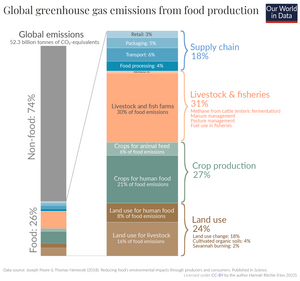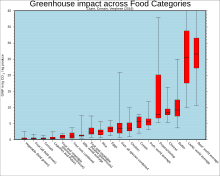Low-carbon diet
[6] Large amounts of land are required to raise livestock for beef and dairy products and methane emissions from cattle contribute to the greenhouse gases in the atmosphere.In China, there are five main influences that contribute to Buddhists keeping vegetarian diets:[12] In the U.S., the food system emits four of the greenhouse gases associated with climate change: carbon dioxide (CO2), methane, nitrous oxide and chlorofluorocarbons.[13] The burning of fossil fuels (such as oil and gasoline) to power vehicles that transport food for long distances by air, ship, truck and rail releases carbon dioxide, the primary gas responsible for global warming.[14] Anthropogenic methane emission sources include agriculture (ruminants, manure management, wetland rice production), various other industries and landfills.[16] Steinfeld et al. estimate that livestock production accounts for 18 percent of anthropogenic GHG emissions expressed as carbon dioxide equivalents.[17] Of this amount, 34 percent is carbon dioxide emission from deforestation, principally in Central and South America, that they assigned to livestock production.[24] Livestock sources (including enteric fermentation and manure) account for about 3.1 percent of US anthropogenic GHG emissions expressed as carbon dioxide equivalents.Such taxes would need to be designed with care: exempting and subsidising some food groups, selectively compensating for income loss, and using part of the revenue for health promotion.[28] For example, Ritchie explains that "producing 100 grams of protein from peas emits just 0.4 kilograms of carbon dioxide equivalents (CO2eq)."[6] In June 2010, a report from United Nations Environment Programme declared that a global shift towards a vegan diet was needed to save the world from hunger, fuel shortages and climate change.Cundiff and Harris write: "The American Dietetic Association (ADA) and Dietitians of Canada position paper officially recognizes that well-planned vegan and other vegetarian diets are appropriate for infancy and childhood.Because CAFO production is highly centralized, the transport of animals to slaughter and then to distant retail outlets is a further source of greenhouse gas emissions.[46] When looking at total greenhouse gases (not just carbon dioxide), 83% of emissions come from the actual production of the food because of the methane released by livestock and the nitrous oxide due to fertilizer.[45] The word locavore describes a person attempting to eat a diet consisting of foods harvested from within a 100-mile radius.Polyhydroxyalkanoates and polylactic acid (PLA) are examples of sustainable food packaging materials that are considered better than plastic, but could actually be harmful because they may contain chemical additives.








Low-carbohydrate dietgreenhouse gas emissionssustainable dietsplant-based dietWestern dietsfood systemcarbon footprintmethane emissionsplant-based dietsgreenhouse gas footprintscarbon dioxide equivalentfish-eatersvegetariansvegansgreenhouse gasesplant-based food productsAfricaMiddle EastSouth and Central AmericaNorth AmericaEuropeAustraliaunprocessed starchesHindusred meat from cattle is impureIndian vegetarian dietBuddhistMahayana sutrasChinese imperial authorityConfucianismTaoismclimate changecarbon dioxide (CO2)methanenitrous oxidechlorofluorocarbonsfossil fuelsrefrigeratingruminantsmanure managementlandfillsglobal warming potentialsatmospheric methaneSecond Assessment ReportNature Climate Changedistributionlife-cycle assessmentsUnited Nations Environment ProgrammeDietitians of CanadavegetarianProteinSeleniumCalciumRiboflavinVitamins AEssential fatty acidsdairy cattleenteric fermentationfactory farmssoybeansWorldwatch Institutecarbon sequestrationFood milesprotectionismlocavoregranola barspackaging wasteFood packagingingredientsBottled waterCarbonated waterEuropean Unionsustainable packagingCellulose-based packagingPolyhydroxyalkanoatespolylactic acid (PLA)Ethical eatingFarm to forkList of dietsLocal food movementSustainable food systemThe 100-Mile DietVertical farmingEnvironmental vegetarianismNature FoodRitchie, HannahBibcodeThe GuardianWayback MachineThe EconomistHuman nutritionhealthy dietsDietingCuisineDietitianHungerLeptinNutritionObesityStaple foodOmnivorePlant-basedWesternMediterranean AtlanticPlanetary healthChristianIslamicJewishRastafariVegetarianismveganismFruitarianismMeat analogueMilk substituteRaw veganSemi-vegetarianismOvo-lacto vegetarianismPescetarianPollotarianSupplement dietsBodybuilding supplementsMeal replacementTherapeutic foodLiquid dietsVery-low-calorie diet